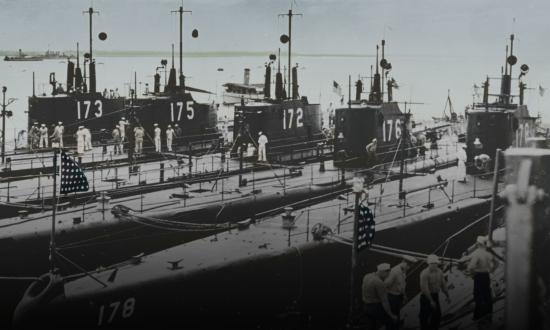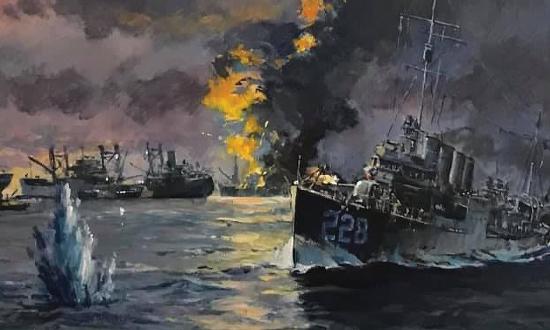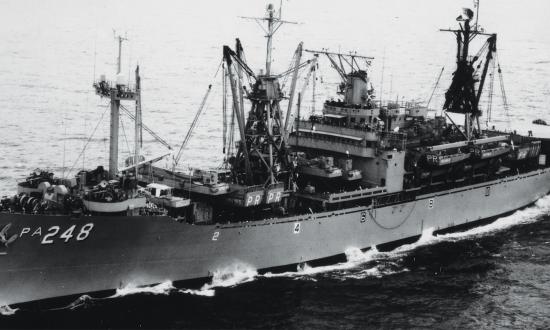In the early days of the Pacific war, future Admiral Stuart S. Murray was commander of Submarine Division 15 at Manila, participating in the defense of the Philippines and Dutch East Indies, and then chief of staff and aide to Commander Submarine Force, Southwest Pacific. In this excerpt from his U.S. Naval Institute oral history, he offers an account of the events leading up to—and the sad aftermath of—the 27 February 1942 Battle of the Java Sea:
When we got back into Bandung [headquarters, Commander U.S. Naval Forces Southwest Pacific], things were going along about as usual, except that the Battle of the Java Sea was shaping up in nothing flat.
In fact, the Allied fleet had taken to sea from the Gulf of Madura and had gone off into the Java Sea to meet the Japanese main battle fleet, which was coming down. From all the reports of the submarines and PBYs who would go up and get shot at, they had a carrier task force—battleships, cruisers, destroyers all around them—so they were just coming right on down. They had already captured Balikpapan, the big oil station on Borneo. (See “First Strike,” pp. 26–33.) They also captured Makassar City over on Celebes Island.
They were moving down; there was no question about it. The submarines would report them up and down the Makassar Strait, coming down. We tried to get in on them, but the destroyers were faster, so we deployed all of our submarines that were available at various places in the Sea of Java. The Dutch had employed theirs also along the beaches. The Dutch had also mined part of the approach areas for landing beaches, with their own mines.
About the 25th of February, they were in most of the positions or coming rapidly to it. We had pulled all our submarines from the eastern part of the Malay Barrier and also from west and pulled them down through Sunda Strait and into the western end of the Sea of Java. The ones that were going there were running at maximum speed in order to get on location.
We got the submarines as near places as we could, and the order to the Dutch submarines was, “Prevent a landing, or don’t come back.” The orders to the Dutch ships were that they would not return to port unless they had defeated the Japanese forces. That sounds like a good thing in print and so forth, but it is kind of foolish if you know you’re going to be licked.
This Allied force, as I recall, consisted of about four cruisers—the U.S. heavy cruiser Houston [CA-30], the Australian heavy cruiser Perth, and two Dutch light cruisers—and the destroyers that we had. I think we had about 12 or 15, the remnants of the Asiatic Fleet there; the Dutch had half a dozen destroyers; the British had two or three.
The plan was that it would be a night battle, which is the only thing an inferior force could do, naturally, against a superior force. I think the battle could best be described by Captain Albert H. Rooks, commanding officer of the Houston. The night after the Battle of the Java Sea, he called up to report in and ask for orders. He said, “The battle can best be described in a few words: A night action was fought at 4 o’clock in the afternoon with the sun two and a half hours high.” He said, “I’ve got one turret that’s blown up—it’s useless—and my speed is reduced to about 20 knots.” The Perth had gotten into Surabaya, and she was down to about 15 knots. Some of the destroyers had gotten into Batavia, and some had gotten into Surabaya.
We were warned that there was intelligence that a Japanese carrier task force was loose in the Indian Ocean, down south of the Dutch East Indies. They told the Houston to proceed out through Sunda Strait. The Perth was getting under way immediately to join her. They were both to go on out, and some British destroyers and a Dutch destroyer were going with them. So they went on out through there, and, as is known in history, the whole group was sunk by the Japanese.
They had met a Japanese task force coming in—headed north through Sunda Strait the same time they were headed south.
To learn more about the U.S. Naval Institute Oral History Program, visit the program’s webpage at usni.org/archives/oral-histories.







